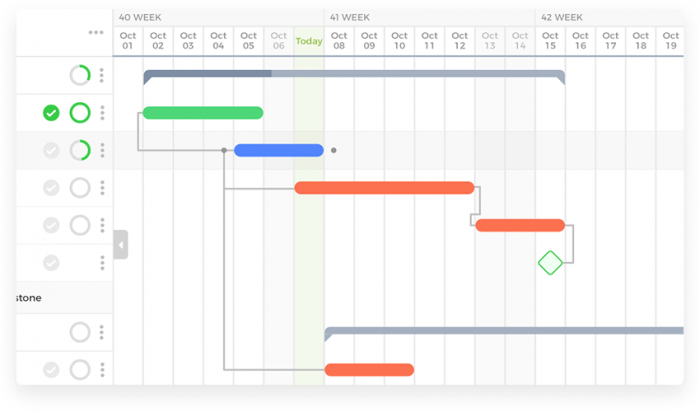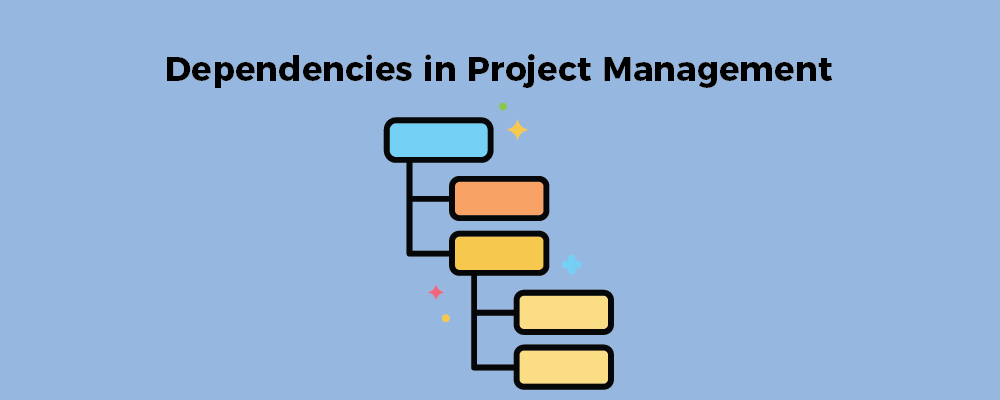This article covers the following issues in detail:
- Criteria for dependencies selection.
- A brief look at what are dependencies in project management
- 6 types of project management dependencies
- What is the role of task dependencies in project management?
- What to do about dependencies?
- FAQs
1. Criteria for dependencies selection
Different project management experts have different opinions on which dependencies are ‘worth knowing’.
We have done some digging of our own and selected these 6 because:
- They cover almost all other dependencies
- They are the most common dependencies in projects
- Majority of the experts include these in their list of must-know-about dependencies
2. A brief look at what are dependencies in project management
Simply put, if two or more tasks can’t be started or finished without the starting or completion of any other task, they are said to have a dependency on other tasks.
Pretty straightforward, right?
Here’s an example to help you further understand the concept:
The binding of a book is not possible without first completing and editing the book. Thus, we can say that Task B (binding) is dependent on Task A (completion).
3. 6 types of project management dependencies
We are going to get straight to it now as this is what you really came here for:
1. Finish to start dependency

There’s a high chance that you have encountered this dependency on projects. here’s how it works.
If Task A is completed, only then Task B can be started. Task B has to use the output of Task A to start.
For example, the paint job of a car can be done only if the body of the car is ready
2. Start to finish dependency

This dependency is a bit tricky. You might have to read about it more than once.
So, from start to finish, Task B can’t finish unless Task A has started. Once the predecessor task has started, Task B can finish any time.
For example, if the shift of one guard can only finish if the second guard shows up.
3. Start to start dependency

Thankfully, this dependency is not hard to get a grip of.
It simply states that Task B can only start once Task A has initiated. After this, they can go on simultaneously.
For example, you can only start editing a writing piece once you have started writing it.
4. Finish to finish dependency

Finish to finish or FF dependency is even easier to understand than start to start.
It means you can’t finish a task until another task has been completed.
Cash on delivery, an online shopping payment is a good example. You can’t close the sale before the delivery of the product and the handing over of the money by the customer.
5. Causal Dependency
They are also called ‘logical dependencies‘.
It’s pretty self-explanatory. These are the dependencies that can’t be avoided. Why? Because this dependency stems from the nature of the tasks.
For example, without completing an activity, you can’t monitor it or get feedback. It’s impossible.
Causal dependencies are pretty obvious and it’s rare that project managers don’t know about them.
6. The Outside – Inside Dependencies
We all know about the micro and macro environment of the workplace.
There is a total of 4 such dependencies which are related to the internal (micro) and external (macro) factors.
Company In – Project In Dependencies
These are applied to sequential tasks. You have to preplan about them. Ad hoc methods won’t work.
Company In – Project Out Dependencies
These dependencies where another department of the company is roped in for the completion of a certain task (s). It may be a single task or a number of tasks that can’t be done in your department.
Company Out – Project In Dependencies
These are for the tasks that are outsourced to third parties. The outcome of the project still impacts your company, but the activities are not in your control.
Company Out – Project Out Dependencies
There are some factors that are outside the company control and not part of the project, but they affect the outcome of the project. For example, worker unions, etc.
Some other types of dependencies that you need to know as an Agile professional:
1. Lead
If a dependency is not limited by constraints and logic, rather it considers best practice or is convenient to do – the dependent task can start ahead of its time. For example, the coloring of a part of drawing/painting can be started before the whole thing is drawn.
Now, moving on, let’s see what Lag is all about.
2. Lag
It is simply the added wait time added between activities. Like, testing a prototype before getting it out in the market.
3. Resource-based dependencies
It is simply a dependency where task (s) requires the availability of a certain resource to be completed. For instance, successful completion of a task where a lot of hands are required can be done only if there is enough man force.
4. Preferential dependencies
It is the expert-opinion driven delay or requirement that is added by the workers. Like a mechanic may ask you to not floor it after just getting some modifications done to the engine or any other part.
4. What is the role of task dependencies in project management?
Dependencies help immensely during the scheduling of your projects.
The perks of living in the tech age are that everything can be made easy using the software. Project managers of today use Gantt charts to show dependencies.
We’ll talk more about Gantt charts after this.
As a project manager, imagine knowing every dependency in your project. The first thing that you would be able to do is allocate the right resources, to the right tasks, at the right time.
Also, it would be easier for you to plan and meet deadlines.
Something to think about.
5. What to do about dependencies in any PM related scenario?

Take advantage of them, of course!
But how to do it?
Follow these simple steps:
Go on a search engine – type “amazing project management software” – select the one that fits – start using it.
It’s that simple.
Modern project management tools have task dependencies as an integral part of the dashboard.
Moreover, such programs use Gantt charts to depict task dependencies. This makes it extremely easy to track project progress on the go.
But these software don’t stop there; they use the Critical path method to provide you with further insights.
A handy software like nTask does all the work for you. Try it for FREE and see what you have been missing!
FAQs
1. What is the critical path in project management?
The critical path is the total time of all activities that can’t be skipped in a project. Collectively, it makes the total duration of project completion.
2. What is the difference between assumptions and dependencies?
Assumptions are something that has to be made in projects to estimate certain things like the outcome or the budget. Assumptions don’t have any practical back because it’s about the future. However, assumptions are based on historical data, trends, etc.
Dependencies in a project are when two or more tasks can’t be started/finished independently.
3. How do you identify dependencies?
Please ensure that you go through each and every task in the project. Start from the very first tasks and move forward. If any successive task is dependent on the current task, that means there exists a dependency between the tasks.
If any two or more tasks can be started/completed independently, there doesn’t exist any dependency between the tasks.
4. What is start-to-start in project management?
As per this dependency, the successor task can begin only when the predecessor task has initiated. After that, both tasks can go on parallelly.
Over to you!
Now that you know why it’s crucial to know about project dependencies, its time to use this newly learned knowledge in the planning and scheduling phase of your projects.
Was this article helpful? Let us know in the comment section below.

